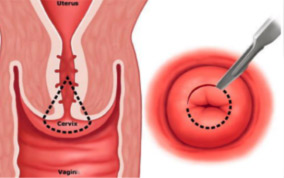Partial removal of the cervix (conization)
Conization involves surgically removing a portion of the cervix
Diagram of a conization

What is a conization ?
Conization (cone biopsy) consists of surgically removing a portion of the cervix.
The removed part is conical, its base is 1 to 2 cm wide, and its height averages 15 mm. It is most often performed in the presence of cervical abnormalities. Without treatment, these lesions can evolve after several years into cervical cancer of the uterus, which justifies the preventive removal of a portion of it.
The surgery has two main purposes.
What happens during the operation?
The procedure can be performed, depending on the case, under general or loco-regional (epidural or spinal) anaesthesia.
Conization is performed by natural means.
Are there any inconveniences or risks?
Conization is a common procedure that involves little risk.
The main risk is bleeding, especially in the first hours, and during the 15 days following surgery. In event of continuous bleeding you must consult the surgeon as soon as possible. Severe bleeding may require a packing to be placed inside the vagina using a mesh (compress). In rare cases, reoperation may be necessary.
Conization may cause some temporary pain similar to that of painful periods.
This surgery preserves the possibility of future pregnancy. The effects on fertility are rare. There is a slightly increased risk of preterm delivery for subsequent pregnancies, and you should mention this history of conization to your doctor in the event of later pregnancy.
Cervix narrowing (stenosis) can occur later, which prevents normal menstrual flow and subsequent cervix observation. This stenosis may require a simple dilatation and, rarely, reoperation. In rare cases, it can cause difficulty when opening the cervix during childbirth.








